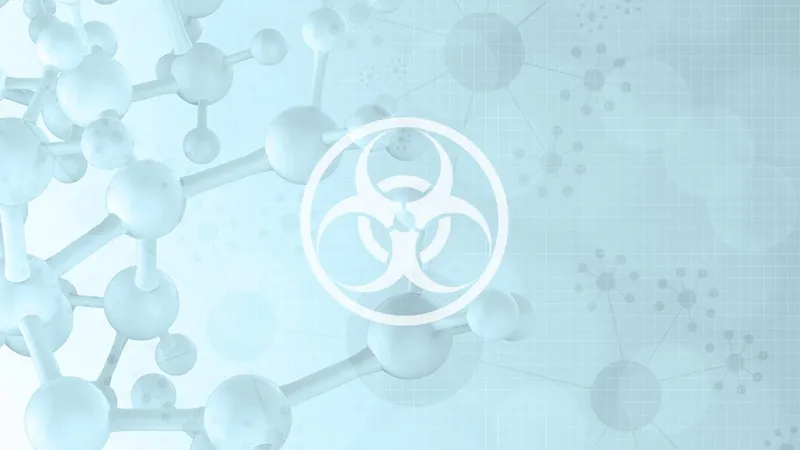
Revolutionizing Pathogen Detection: Argonaute Proteins Lead the Charge
2025-06-05
Author: Li
The Urgent Need for Advanced Diagnostics
As infectious disease threats like SARS-CoV-2, influenza, and drug-resistant bacteria loom larger, the demand for rapid, sensitive, and portable diagnostic tools has never been more pressing. A groundbreaking study published in *Pathogens* presents an in-depth review of cutting-edge nucleic acid detection technologies powered by Argonaute (Ago) proteins, conducted by researchers from Zhejiang University School of Medicine and other national research centers in China.
Meet Argonaute: The Game-Changer in Diagnostics
So, what makes Argonaute proteins stand out? Unlike traditional CRISPR/Cas systems that rely on specific recognition sites, Ago proteins can target and cleave RNA or DNA without such limitations. This unique flexibility, alongside their ability to detect single-nucleotide variations, positions Ago-based technologies as a promising next-generation solution for molecular diagnostics—especially vital for low-resource environments and point-of-care scenarios.
Innovative Ago-Powered Detection Platforms
The study showcases a variety of pioneering Ago-based diagnostic systems that are making waves in the scientific community. Here are some notable innovations: - **PAND**: Utilizes a thermophilic Argonaute to cleave target DNA while amplifying signals via fluorescent probes, achieving incredible attomolar sensitivity. - **A-Star**: A clever one-tube PCR approach that allows for precise detection of single-nucleotide variants through selective amplification of mutants. - **USPCRP**: Combines ultra-short primers with PfAgo for highly specific DNA cleavage and detection using minimal reagents. - **TEAM**: Merges TtAgo's specificity with exponential isothermal amplification to detect microRNA at single-molecule sensitivity. - **MULAN**: Facilitates rapid, portable multiplexing for detecting viruses like SARS-CoV-2 and influenza A/B in under 45 minutes. - **PASS**: An innovative, amplification-free platform that combines Argonaute cleavage with deep learning for signal quantification.
Real-World Applications Making an Impact
These technologies aren't just theoretical; they're being applied to critical public health issues. Here’s how: - **Bacterial Infections**: Efficient detection of multidrug-resistant *Klebsiella pneumoniae* from blood and urine samples. - **Viral Infections**: The portable MULAN system differentiates between Influenza A/B and SARS-CoV-2 efficiently. - **Fungal and Food Safety Testing**: Detects harmful mycotoxins in food using microsphere encoding platforms guided by CbAgo. - **Aquaculture Pathogens**: On-site detection of harmful pathogens in shrimp farming operations to ensure early intervention.
Pros and Cons of Argonaute Technologies
The review highlights the strengths of Ago-based diagnostics, such as: - Exceptional specificity down to individual nucleotide mutations. - PAM-independent targeting, providing increased design flexibility. - Cost-effective and stable guide DNAs suitable for field use. - Potential for rapid results, often within 30 minutes. However, challenges exist that researchers must overcome: - Many systems require complex multi-step processes. - Limitations in the thermal stability of common Ago proteins can restrict some platforms to high-temperature environments. - There's a need to enhance signal output modalities and reduce false positive rates.
What Lies Ahead for Argonaute Diagnostics?
The study calls for a fusion of Argonaute diagnostics with upcoming technologies like microfluidics, AI-driven probe design, and multi-sensing platforms, such as electrochemical and Raman spectroscopy. The vision is clear: self-contained, amplification-free detection kits for use in clinics, homes, farms, and remote outbreak zones. As researchers refine these systems with innovative engineering, the potential for Argonaute-based detection technologies to support rapid responses and real-time surveillance is limitless, crucial for navigating today’s global health challenges.




 Brasil (PT)
Brasil (PT)
 Canada (EN)
Canada (EN)
 Chile (ES)
Chile (ES)
 Česko (CS)
Česko (CS)
 대한민국 (KO)
대한민국 (KO)
 España (ES)
España (ES)
 France (FR)
France (FR)
 Hong Kong (EN)
Hong Kong (EN)
 Italia (IT)
Italia (IT)
 日本 (JA)
日本 (JA)
 Magyarország (HU)
Magyarország (HU)
 Norge (NO)
Norge (NO)
 Polska (PL)
Polska (PL)
 Schweiz (DE)
Schweiz (DE)
 Singapore (EN)
Singapore (EN)
 Sverige (SV)
Sverige (SV)
 Suomi (FI)
Suomi (FI)
 Türkiye (TR)
Türkiye (TR)
 الإمارات العربية المتحدة (AR)
الإمارات العربية المتحدة (AR)